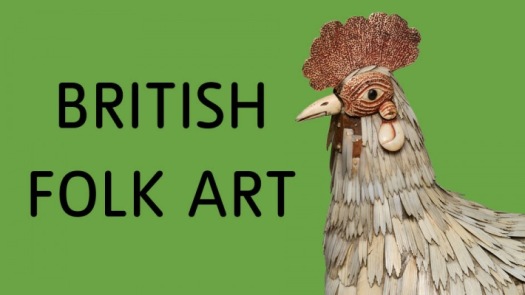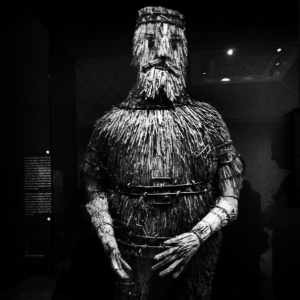 I had been looking forward to viewing this exhibition for quite some time, particularly as a number of the items were brought in on loan from Norfolk’s museum services. Generally speaking, I prefer the offerings of the traditional crafts movement over other forms of creative practice. For me, the tactile nature of handcrafted objects, the rawness that is visibly evident in many (not all) of its works, makes for a more engaging aesthetic. The works of folk craft being functional as well as decorative pieces, always seem to convey a sense of ceremony that is not so often present in contemporary art. I think the greatest attraction for me though, is that I grew up around the production and celebration of this type of art.
I had been looking forward to viewing this exhibition for quite some time, particularly as a number of the items were brought in on loan from Norfolk’s museum services. Generally speaking, I prefer the offerings of the traditional crafts movement over other forms of creative practice. For me, the tactile nature of handcrafted objects, the rawness that is visibly evident in many (not all) of its works, makes for a more engaging aesthetic. The works of folk craft being functional as well as decorative pieces, always seem to convey a sense of ceremony that is not so often present in contemporary art. I think the greatest attraction for me though, is that I grew up around the production and celebration of this type of art.
My grandparent’s home was always decorated with art they had produced themselves, as well as objects that carried a sense of family memory and identity with them. The hallway was adorned with old horse brasses collected by great grandfather, who apparently had one of the largest collections of brasses in Norfolk. My grandfather, like his father before him, had worked the land with shire horse, cart and plough. I remember him as a large, stern man, who was always very matter of fact. And yet, the love he had for his surroundings was clearly and emotively expressed in the oil paintings he produced; autumnal sunsets over the salt marshes of the North Norfolk coast; water and land doused in splashes of gold and amber; small sailing vessels returning at the end of a day’s fishing. I believe that he painted not only for the joy of the art, but moreover, as a way of recording, of preserving the history of the places he loved and putting the feelings that he refused to convey verbally (at least to us children) onto the form of the canvas.
Together with the craft-works of my grandmother, their lounge was amassed with hand painted teapots and toby jugs, old maps, samplers, needle worked pictures, paintings, cushions and quilts that my family had made. My grandmother, a master quilt maker, continues to produce intricately patterned quilted blankets for the family, all of which take her months to produce and which she invariably uses to showcase her wealth of needle skills through a variety of stitching and pattern formations. She’s a dab hand with a pair of knitting needles too, though I often feel guilt ridden at asking an eighty nine year old to produce ‘wool free’ jumpers for me each winter, particularly as she never lets me pay for the materials.
So yes, much excitement over this recent exhibition, excitement that was sadly not to last. The curation, in my opinion, was poor; too many items per wall, much too little space and not enough information, moreover many of the items were hung well above eye level making it hard to really engage with them. The objects themselves were of course, beautiful, and to be fair there was a logical running order to the exhibition. However, the walls were scattered with objects which were presented in such a way as to detract the viewer from distinguishing the quality and unique characteristics of one piece from that of another. The general omission of information on the history of the pieces, and the craft behind them, detracted from the sense that the works were something special, that they differed from the landscapes and portraiture that adorned the walls of the surrounding gallery halls. I visited the exhibition during the last week of its running and it was reassuringly busy, proving that the Tate did succeed in producing an engaging and relevant show even if it got the overall presentation wrong.
 On another positive note, the sheer number of objects gathered was indeed impressive. The collection of sewn maps was particularly interesting (at least it was for a geographer) and the large straw man, an obvious highlight of the exhibition, was every bit as enchanting as you would imagine. The carved wooden signs were also attractive looking objects and as with the maps, there was a rare opportunity for the eye to distinguish the mark of the craftsman upon them. The quilted blankets and tapestries, a few of which dated back a couple of centuries, were another example of some of the more interesting pieces; although presenting the objects flush against the wall meant that the viewer was denied all of the intricate detail of the needlework that was to be seen on the work’s reverse.
On another positive note, the sheer number of objects gathered was indeed impressive. The collection of sewn maps was particularly interesting (at least it was for a geographer) and the large straw man, an obvious highlight of the exhibition, was every bit as enchanting as you would imagine. The carved wooden signs were also attractive looking objects and as with the maps, there was a rare opportunity for the eye to distinguish the mark of the craftsman upon them. The quilted blankets and tapestries, a few of which dated back a couple of centuries, were another example of some of the more interesting pieces; although presenting the objects flush against the wall meant that the viewer was denied all of the intricate detail of the needlework that was to be seen on the work’s reverse.
Despite the obvious downsides to the show (poor presentation, lack of space etc), I would nonetheless recommend visiting the exhibition when it makes its next stop at Compton Verney, in Warwickshire. I can imagine this second setting being far more in keeping with what the curators were hoping to achieve with the exhibition. The exhibition will run from 27 September to 14 December 2014.
Price: Adults £15, Concessions £13.50.
